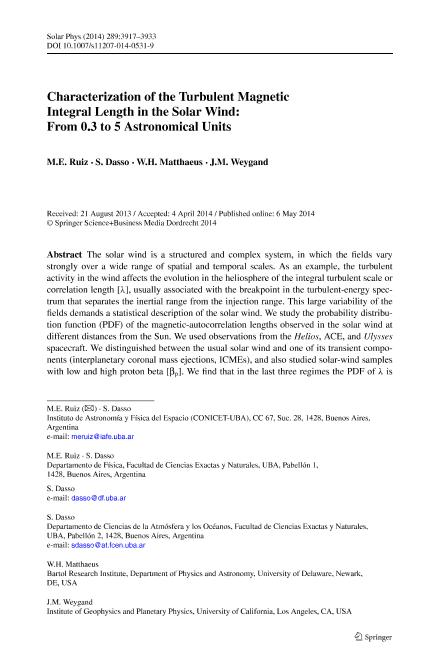Mostrar el registro sencillo del ítem
dc.contributor.author
Ruiz, Maria Emilia

dc.contributor.author
Dasso, Sergio Ricardo

dc.contributor.author
Matthaeus, W. H.
dc.contributor.author
Weygand, J. M.
dc.date.available
2017-05-12T22:28:36Z
dc.date.issued
2014-10
dc.identifier.citation
Ruiz, Maria Emilia; Dasso, Sergio Ricardo; Matthaeus, W. H.; Weygand, J. M.; Characterization of the turbulent magnetic integral length in the solar wind: from 0.3 to 5 astronomical units; Springer; Solar Physics; 289; 10; 10-2014; 3917-3933
dc.identifier.issn
0038-0938
dc.identifier.uri
http://hdl.handle.net/11336/16455
dc.description.abstract
The solar wind is a structured and complex system, in which the fields vary strongly over a wide range of spatial and temporal scales. As an example, the turbulent activity in the wind affects the evolution in the heliosphere of the integral turbulent scale or correlation length [λ], usually associated with the breakpoint in the turbulent-energy spectrum that separates the inertial range from the injection range. This large variability of the fields demands a statistical description of the solar wind. We study the probability distribution function (PDF) of the magnetic-autocorrelation lengths observed in the solar wind at different distances from the Sun. We used observations from the Helios, ACE, and Ulysses spacecraft. We distinguished between the usual solar wind and one of its transient components (interplanetary coronal mass ejections, ICMEs), and also studied solar-wind samples with low and high proton beta [βp]. We find that in the last three regimes the PDF of λ is a log-normal function, consistent with the multiplicative and nonlinear processes that take place in the solar wind, the initial λ (before the Alfvénic point) being larger in ICMEs.
dc.format
application/pdf
dc.language.iso
eng
dc.publisher
Springer

dc.rights
info:eu-repo/semantics/openAccess
dc.rights.uri
https://creativecommons.org/licenses/by-nc-sa/2.5/ar/
dc.subject
Magnetohydrodynamics
dc.subject
Turbulence
dc.subject
Magnetic Fields, Interplanetary
dc.subject
Solar Wind, Theory
dc.subject
Coronal Mass Ejections, Interplanetary
dc.subject.classification
Astronomía

dc.subject.classification
Ciencias Físicas

dc.subject.classification
CIENCIAS NATURALES Y EXACTAS

dc.title
Characterization of the turbulent magnetic integral length in the solar wind: from 0.3 to 5 astronomical units
dc.type
info:eu-repo/semantics/article
dc.type
info:ar-repo/semantics/artículo
dc.type
info:eu-repo/semantics/publishedVersion
dc.date.updated
2017-05-02T20:13:36Z
dc.identifier.eissn
1573-093X
dc.journal.volume
289
dc.journal.number
10
dc.journal.pagination
3917-3933
dc.journal.pais
Países Bajos

dc.journal.ciudad
Dordrecht
dc.description.fil
Fil: Ruiz, Maria Emilia. Consejo Nacional de Investigaciónes Científicas y Técnicas. Oficina de Coordinación Administrativa Ciudad Universitaria. Instituto de Astronomía y Física del Espacio. - Universidad de Buenos Aires. Facultad de Ciencias Exactas y Naturales. Instituto de Astronomía y Física del Espacio; Argentina. Universidad de Buenos Aires. Facultad de Ciencias Exactas y Naturales. Departamento de Física; Argentina
dc.description.fil
Fil: Dasso, Sergio Ricardo. Universidad de Buenos Aires. Facultad de Ciencias Exactas y Naturales. Departamento de Física; Argentina. Consejo Nacional de Investigaciónes Científicas y Técnicas. Oficina de Coordinación Administrativa Ciudad Universitaria. Instituto de Astronomía y Física del Espacio. - Universidad de Buenos Aires. Facultad de Ciencias Exactas y Naturales. Instituto de Astronomía y Física del Espacio; Argentina
dc.description.fil
Fil: Matthaeus, W. H.. University of Delaware; Estados Unidos
dc.description.fil
Fil: Weygand, J. M.. University of California; Estados Unidos
dc.journal.title
Solar Physics

dc.relation.alternativeid
info:eu-repo/semantics/altIdentifier/doi/http://dx.doi.org/10.1007/s11207-014-0531-9
dc.relation.alternativeid
info:eu-repo/semantics/altIdentifier/url/https://link.springer.com/article/10.1007%2Fs11207-014-0531-9
Archivos asociados
